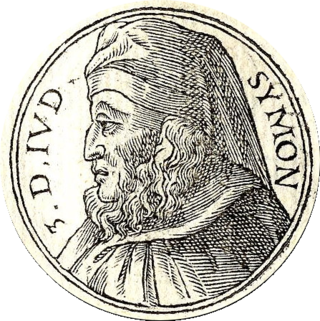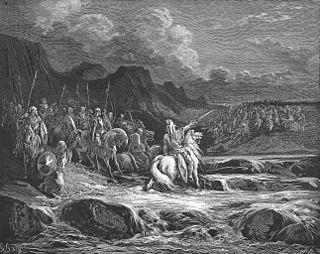Related Research Articles

Demetrius I, surnamed Soter, reigned as king (basileus) of the Hellenistic Seleucid Empire from November 162 – June 150 BC. Demetrius grew up in Rome as a hostage, but returned to Greek Syria and overthrew his young cousin Antiochus V Eupator and regent Lysias. Demetrius took control during a turbulent time of the Empire, and spent much of his time fighting off revolts and challenges to his power from threats such as Timarchus and Alexander Balas.

The Maccabees, also spelled Machabees, were a group of Jewish rebel warriors who took control of Judea, which at the time was part of the Seleucid Empire. They founded the Hasmonean dynasty, which ruled from 167 BCE to 37 BCE, being a fully independent kingdom from about 110 to 63 BCE. They reasserted the Jewish religion, expanded the boundaries of Judea by conquest, and reduced the influence of Hellenism and Hellenistic Judaism.

The Hasmonean dynasty was a ruling dynasty of Judea and surrounding regions during classical antiquity, from c. 140 BCE to 37 BCE. Between c. 140 and c. 116 BCE the dynasty ruled Judea semi-autonomously in the Seleucid Empire, and from roughly 110 BCE, with the empire disintegrating, Judea gained further autonomy and expanded into the neighboring regions of Perea, Samaria, Idumea, Galilee, and Iturea. The Hasmonean rulers took the Greek title basileus. Forces of the Roman Republic conquered the Hasmonean kingdom in 63 BCE and made it into a client state; Herod the Great displaced the last reigning Hasmonean client-ruler in 37 BCE.

Simon Thassi was the second son of Mattathias and thus a member of the Hasmonean family.
1 Maccabees, also known as the First Book of Maccabees, First Maccabees, and abbreviated as 1 Macc., is a deuterocanonical book which details the history of the Maccabean Revolt against the Seleucid Empire as well as the founding and earliest history of the independent Hasmonean kingdom. It describes the promulgation of decrees forbidding traditional Jewish practices by King Antiochus IV Epiphanes and the formation of a rebellion against him by Mattathias of the Hasmonean family and his five sons. Mattathias's son Judas Maccabeus takes over the revolt and the rebels as a group are called the Maccabees; the book chronicles in detail the successes and setbacks of the rebellion. While Judas is eventually killed in battle, the Maccabees eventually achieve autonomy and then independence for Judea under the leadership of the Hasmonean family. Judas's brother Simon Thassi is declared High Priest by will of the Jewish people. The time period described is from around 170 BC to 134 BC.
2 Maccabees, also known as the Second Book of Maccabees, Second Maccabees, and abbreviated as 2 Macc., is a deuterocanonical book which recounts the persecution of Jews under King Antiochus IV Epiphanes and the Maccabean Revolt against him. It concludes with the defeat of the Seleucid Empire general Nicanor in 161 BC by Judas Maccabeus, the leader of the Maccabees.

John Hyrcanus was a Hasmonean (Maccabean) leader and Jewish high priest of the 2nd century BCE. In rabbinic literature he is often referred to as Yoḥanan Cohen Gadol, "John the High Priest".

The Battle of Beth Zechariah was a battle around May 162 BC during the Maccabean revolt fought between Jewish rebels under the leadership of Judas Maccabeus against an army of the Seleucid Empire, the Greek successor state (diadochi) to the Macedonian conquests that controlled Syria and Babylonia. The battle was fought at Beth Zechariah and was a Seleucid victory, with the rebels driven from the field in retreat. Judas's brother Eleazar Avaran died in combat with a war elephant. The defeat allowed the Seleucids to continue their campaign and besiege the Jewish holy city of Jerusalem.

The Battle of Elasa was fought in April 160 BCE during the Maccabean Revolt between Judean rebels led by Judas Maccabeus and an army of the Seleucid Empire under the command of Bacchides. The battle resulted in the triumph of the Greek Syrian forces, the defeat of the Maccabees, and the death of Judas Maccabeus.

The Battle of Emmaus took place around September 165 BC during the Maccabean Revolt between Judean rebels, led by Judas Maccabeus, and an expedition of Seleucid Empire forces under generals Gorgias, Ptolemy the son of Dorymenes, and Nicanor near Emmaus. The battle was won by the Maccabee rebels, who marched by night and surprised the Seleucid camp while many soldiers were absent. The victorious Maccabees looted the Greek camp for valuables and likely weapons to help further their cause.
The Books of the Maccabees or the Sefer HaMakabim recount the history of the Maccabees, the leaders of the Jewish rebellion against the Seleucid dynasty.

The Battle of Beth Horon or Battle with Seron was fought at some point between Spring 166 BC to Spring 165 BC during the Maccabean Revolt between Judean rebels led by Judas Maccabeus and an army of the Seleucid Empire under the command of Seron, a commander of the Syrian army. Beth-Horon, or Bethoron, was a strategic mountain pass leading from the coastal plain to the Judean hill country. Utilizing guerrilla warfare tactics, the Maccabee rebels ambushed the passing Seleucid force from the pass, pursuing the surprised and fleeing remnants into the plain.
The Battle of Adasa was fought during the Maccabean revolt on the 13th of the month Adar, 161 BC at Adasa, near Beth-horon. It was a battle between the rebel Maccabees of Judas Maccabeus and the Seleucid Empire, whose army was led by Nicanor. The Maccabees won the battle after killing Nicanor early in the fighting. The battle came after a period of political maneuvering over several months where the peace deal established a year earlier by Lysias was tested by new High Priest Alcimus, new military governor Nicanor, and Maccabee leader Judas Maccabeus.
Bacchides was a Syrian-Greek general and governor (strategos) and friend and advisor (philoi) of King Demetrius I Soter of the Seleucid Empire. The Seleucid Empire was one of the Greek successor states (diadochi) founded after the conquests of Alexander the Great, and was centered in Syria and Babylonia in the Hellenistic era.

The Acra, with the meaning of "stronghold", was a place in Jerusalem thought to have had a fortified compound built by Antiochus Epiphanes, ruler of the Seleucid Empire, following his sack of the city in 168 BCE. The name Acra was also used at a later time for a city quarter probably associated with the by-then destroyed fortress, known in his time to Josephus as both Acra and "the lower city". The fortress played a significant role in the events surrounding the Maccabean Revolt, which resulted in the formation of the Hasmonean Kingdom. The "upper city" was captured by Judas Maccabeus, with the Seleucid garrison taking refuge in the "Acra" below, and the task of destroying this last enemy stronghold inside Jerusalem fell to Simon Maccabeus surnamed Thassi. Our knowledge about the Acra is based almost exclusively on the writings of Josephus, which are of a later date, and on the First and Second Books of Maccabees, which were written not long after the described events.
The Hasideans were a Jewish group during the Maccabean Revolt that took place from around 167–142 BCE. The Hasideans are mentioned three times in the books of the Maccabees, the main contemporary sources from the period. According to the book 1 Maccabees, during the early phases of the anti-Jewish decrees and persecution proclaimed by King Antiochus IV Epiphanes, some Hasideans joined up with Mattathias the Hasmonean as he martialed forces and allies for his rebellion. Later on, during the term of High Priest Alcimus, some Hasideans apparently trusted Alcimus's promises at first and attempted to negotiate a settlement with the government, but were betrayed and executed. In the book 2 Maccabees, Judas Maccabeus is described as the leader of the Hasideans and of them all as troublemakers disrupting the peace, but by Alcimus, a source the book considers untrustworthy and corrupt.
The Roman–Jewish Treaty was an agreement made between Judas Maccabeus and the Roman Republic according to the book 1 Maccabees and Josephus's Jewish Antiquities. It took place around 161 BCE and was the first recorded contract between the Jewish people and the Romans. The Romans apparently extended an offer of aid to the Judean rebel side of the Maccabean Revolt. It does not appear the treaty ever resulted in direct action by the Romans, but may have deterred other states from more extreme measures against Judea.

The Maccabean Revolt was a Jewish rebellion led by the Maccabees against the Seleucid Empire and against Hellenistic influence on Jewish life. The main phase of the revolt lasted from 167–160 BCE and ended with the Seleucids in control of Judea, but conflict between the Maccabees, Hellenized Jews, and the Seleucids continued until 134 BCE, with the Maccabees eventually attaining independence.
Ptolemy son of Abubus was an official in the early Hasmonean kingdom which then controlled Judea. According to the book of 1 Maccabees, in 135 BC, he served as the governor of Jericho. While High Priest Simon Thassi was visiting, Ptolemy orchestrated the murder of Simon and two of his sons, as well as some of Simon's servants. This act of betrayal of guest right earned Ptolemy a place in Dante's The Divine Comedy; one of the sections of the ninth layer of hell described in Inferno is called Ptolomea, where those who betray guests in their home suffer.

During the Maccabean Revolt against the Seleucid Empire, there were a series of campaigns in 163 BC in regions outlying Judea - Ammon, Gilead, Galilee, Idumea, and Judea's coastal plain, a wider region usually referred to as either Palestine or Eretz Israel. The Maccabee rebels fought multiple enemies: Seleucid garrisons and hired mercenaries under a commander named Timothy of Ammon, non-Jewish inhabitants hostile to the Maccabees and their Jewish neighbors, and possibly the Tobiad Jews, a clan that generally favored the ruling Seleucid government. During 163 BC, the main Seleucid armies composed of Greeks were elsewhere, so the Maccabees were free to expand their influence against their neighbors.
References
- Ewing, W. (1915). Gazara . International Standard Bible Encyclopedia. Eds. Orr, James, M.A., D.D. Retrieved March 17, 2023.
- ↑ Honigman, Sylvie (2014). Tales of High Priests and Taxes: The Books of the Maccabees and the Judean Rebellion Against Antiochos IV. Oakland, CA: Univ of California Press. p. 166. ISBN 9780520958180.
- ↑ Harrington, Daniel J. (2012). First and Second Maccabees, Volume 12. Collegeville, Minnesota: Liturgical Press. p. 91. ISBN 9780814647820.
- ↑ PEFS, 1905, 26
- 1 2 Xeravits, Géza; Zsengeller, Jozsef (2007). The Books of the Maccabees: History, Theology, Ideology: Papers of the Second International Conference on the Deuterocanonical Books, Pápa, Hungary, 9-11 June, 2005. Leiden: BRILL. p. 55. ISBN 9789004157002.
- ↑ Schürer, Emil (1891). "Simon, B.C. 142–135". A History of the Jewish People in the Time of Jesus Christ. Vol. 1. New York: C. Scribner.